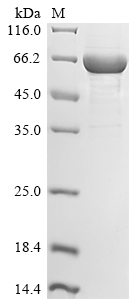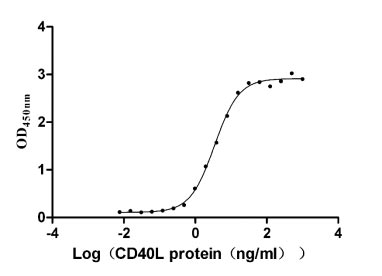Recombinant Human Schlafen family member 11 (SLFN11), partial
In Stock-
货号:CSB-EP021760HU1
-
规格:¥1836
-
图片:
-
其他:
产品详情
-
纯度:Greater than 85% as determined by SDS-PAGE.
-
基因名:
-
Uniprot No.:
-
别名:SLFN11; Schlafen family member 11; EC 3.6.-.-
-
种属:Homo sapiens (Human)
-
蛋白长度:Partial
-
来源:E.coli
-
分子量:69.6 kDa
-
表达区域:345-901aa
-
氨基酸序列EKWVGMMTDTDPDLLQLSEDFECQLSLSSGPPLSRPVYSKKGLEHKKELQQLLFSVPPGYLRYTPESLWRDLISEHRGLEELINKQMQPFFRGILIFSRSWAVDLNLQEKPGVICDALLIAQNSTPILYTILREQDAEGQDYCTRTAFTLKQKLVNMGGYTGKVCVRAKVLCLSPESSAEALEAAVSPMDYPASYSLAGTQHMEALLQSLVIVLLGFRSLLSDQLGCEVLNLLTAQQYEIFSRSLRKNRELFVHGLPGSGKTIMAMKIMEKIRNVFHCEAHRILYVCENQPLRNFISDRNICRAETRKTFLRENFEHIQHIVIDEAQNFRTEDGDWYGKAKSITRRAKGGPGILWIFLDYFQTSHLDCSGLPPLSDQYPREELTRIVRNADPIAKYLQKEMQVIRSNPSFNIPTGCLEVFPEAEWSQGVQGTLRIKKYLTVEQIMTCVADTCRRFFDRGYSPKDVAVLVSTAKEVEHYKYELLKAMRKKRVVQLSDACDMLGDHIVLDSVRRFSGLERSIVFGIHPRTADPAILPNVLICLASRAKQHLYIFPWGGH
Note: The complete sequence including tag sequence, target protein sequence and linker sequence could be provided upon request. -
蛋白标签:N-terminal 10xHis-tagged
-
产品提供形式:Liquid or Lyophilized powder
Note: We will preferentially ship the format that we have in stock, however, if you have any special requirement for the format, please remark your requirement when placing the order, we will prepare according to your demand. -
缓冲液:Tris-based buffer,50% glycerol
-
储存条件:Store at -20°C/-80°C upon receipt, aliquoting is necessary for mutiple use. Avoid repeated freeze-thaw cycles.
-
保质期:The shelf life is related to many factors, storage state, buffer ingredients, storage temperature and the stability of the protein itself.
Generally, the shelf life of liquid form is 6 months at -20°C/-80°C. The shelf life of lyophilized form is 12 months at -20°C/-80°C. -
货期:3-7 business days
-
注意事项:Repeated freezing and thawing is not recommended. Store working aliquots at 4°C for up to one week.
-
Datasheet & COA:Please contact us to get it.
相关产品
靶点详情
-
功能:Inhibitor of DNA replication that promotes cell death in response to DNA damage. Acts as a guardian of the genome by killing cells with defective replication. Persistently blocks stressed replication forks by opening chromatin across replication initiation sites at stressed replication forks, possibly leading to unwind DNA ahead of the MCM helicase and block fork progression, ultimately leading to cell death. Acts independently of ATR. Also acts as an interferon (IFN)-induced antiviral protein which acts as an inhibitor of retrovirus protein syn...显示更多
-
基因功能参考文献:
- SLFN11 contributes to the sensitivity of Ewing sarcoma cells to inhibition of ribonucleotide reductase M2 PMID: 27557498
- SLFN11 is frequently methylated in human colorectal cancer, and the expression of SLFN11 is regulated by promoter region methylation. Methylation of SLFN11 reduced the sensitivity of CRC cells to cisplatin. PMID: 28403629
- SLFN11 is a relevant predictive biomarker of sensitivity to PARP inhibitor monotherapy in SCLC and we identify combinatorial therapy with TMZ as a particularly promising therapeutic strategy that warrants further clinical investigation PMID: 27440269
- DNA methylation at SLFN11 cg10911913 was positively associated with measured levels of all 3 PM2.5 species. PMID: 27982729
- In vivo silencing of SLFN11 was associated with marked deposition of H3K27me3, a histone modification placed by EZH2, within the gene body of SLFN11, inducing local chromatin condensation and gene silencing. PMID: 28196596
- the results identify SLFN11 epigenetic inactivation as a predictor of resistance to platinum drugs in human cancer. PMID: 26625211
- SLFN11 inhibits checkpoint maintenance and homologous recombination repair by promoting the destabilization of the RPA-ssDNA complex, thereby sensitizing cancer cell lines expressing high endogenous levels of SLFN11 to DNA-damaging agents. PMID: 26658330
- SLFN11 has a role as a transcriptional target of EWS-FLI1 and is a determinant of drug response in Ewing sarcoma PMID: 25779942
- SLFN11 expression predicts good better survival in colorectal cancer patients with KRAS exon 2 wild type who have received oxaliplatin based adjuvant chemotherapy. PMID: 26525741
- SLFN11 selectively inhibits viral protein synthesis in HIV-infected cells by means of codon-bias discrimination PMID: 23000900
- SLFN11 expression is causally associated with the activity of DNA-damaging agents in cancer cells, and has a broad expression range in colon and ovarian adenocarcinomas. PMID: 22927417
收起更多
-
亚细胞定位:Nucleus. Chromosome.
-
蛋白家族:Schlafen family
-
组织特异性:Exhibits a wider expression range in ovarian and colon adenocarcinoma than in their corresponding healthy tissues.
-
数据库链接:
HGNC: 26633
OMIM: 614953
KEGG: hsa:91607
STRING: 9606.ENSP00000312402
UniGene: Hs.745059




-AC1.jpg)















